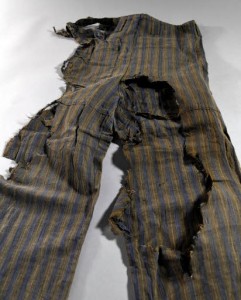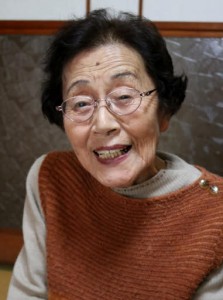Silent Witness: Tattered work pants reveal places where keloid scars formed
Mar. 12, 2018
by Miho Kuwajima, Staff Writer
The monpe work pants were donated to the Hiroshima Peace Memorial Museum in 2015 by Yoko Sumimoto, 85, a resident of Asaminami Ward, who was 12 years old on the day of the bombing. They are shredded as if to show the spots where keloid scars formed on her legs as a result of the heat rays emitted by the atomic bomb. Though in a tattered condition, the trousers lack wrinkles because they were subsequently washed and preserved by her mother.
Ms. Sumimoto’s mother, who died in 2015, gave the trousers to her when she got married at the age of 22. She told her, “You should keep them. If you encounter some difficulties, you can take them out to remind yourself that since you were able to overcome this huge hardship in the past, you’ll be able to deal with any future difficulties as well.” The trousers were carefully wrapped, as if they were a festive piece of clothing.
Back then, Ms. Sumimoto was a first-year student at Second Hiroshima Prefectural Girls High School (now Minami Senior High School). One of the many mobilized students of that time, she was weeding with her classmates in a sweet potato field on the Eastern Drill Ground (now part of Higashi Ward), about 2 kilometers from the hypocenter. She saw a flash and then found that her body had become red and swollen from burns. She took off her clothes, put them in her knapsack, and headed to her school in her underwear. She suffered burns to her thighs, and the blisters on them broke open. She recalls that her shoes became filled with fluid from her body and that, each time she took a step, it felt like the inside of her shoes were wet from walking in the rain.
On the day after the atomic bombing, Ms. Sumimoto was reunited with her mother, but because of her burns, she was unable to move and lay bedridden for about two months. Her mother treated her burns by applying mercurochrome and cooking oil to her skin, day after day. Her burns were very painful, and she often cried.
Keloid scars then formed on the burnt skin of her legs. Because she was young, and didn’t want anyone to see her condition, she wore pants instead of a skirt. After she had two children of her own, she hid away the monpe trousers, given by her mother, in a chest of drawers. She said, “I was happy and they reminded me of the atomic bombing, so I didn’t want to look at them.”
As she grew older, her memories of the atomic bombing grew dim. She donated the trousers to the museum because she was concerned that the tattered piece of clothing might be thrown away after she died. Ms. Sumimoto had gone on with her life, with a positive spirit, without sharing her experience of the atomic bombing with her family. But now she tells her story with the monpe trousers. Ms. Sumimoto hopes that people will see them and feel strongly that such a terrible event must never happen again.
(Originally published on March 12, 2018)
The monpe work pants were donated to the Hiroshima Peace Memorial Museum in 2015 by Yoko Sumimoto, 85, a resident of Asaminami Ward, who was 12 years old on the day of the bombing. They are shredded as if to show the spots where keloid scars formed on her legs as a result of the heat rays emitted by the atomic bomb. Though in a tattered condition, the trousers lack wrinkles because they were subsequently washed and preserved by her mother.
Ms. Sumimoto’s mother, who died in 2015, gave the trousers to her when she got married at the age of 22. She told her, “You should keep them. If you encounter some difficulties, you can take them out to remind yourself that since you were able to overcome this huge hardship in the past, you’ll be able to deal with any future difficulties as well.” The trousers were carefully wrapped, as if they were a festive piece of clothing.
Back then, Ms. Sumimoto was a first-year student at Second Hiroshima Prefectural Girls High School (now Minami Senior High School). One of the many mobilized students of that time, she was weeding with her classmates in a sweet potato field on the Eastern Drill Ground (now part of Higashi Ward), about 2 kilometers from the hypocenter. She saw a flash and then found that her body had become red and swollen from burns. She took off her clothes, put them in her knapsack, and headed to her school in her underwear. She suffered burns to her thighs, and the blisters on them broke open. She recalls that her shoes became filled with fluid from her body and that, each time she took a step, it felt like the inside of her shoes were wet from walking in the rain.
On the day after the atomic bombing, Ms. Sumimoto was reunited with her mother, but because of her burns, she was unable to move and lay bedridden for about two months. Her mother treated her burns by applying mercurochrome and cooking oil to her skin, day after day. Her burns were very painful, and she often cried.
Keloid scars then formed on the burnt skin of her legs. Because she was young, and didn’t want anyone to see her condition, she wore pants instead of a skirt. After she had two children of her own, she hid away the monpe trousers, given by her mother, in a chest of drawers. She said, “I was happy and they reminded me of the atomic bombing, so I didn’t want to look at them.”
As she grew older, her memories of the atomic bombing grew dim. She donated the trousers to the museum because she was concerned that the tattered piece of clothing might be thrown away after she died. Ms. Sumimoto had gone on with her life, with a positive spirit, without sharing her experience of the atomic bombing with her family. But now she tells her story with the monpe trousers. Ms. Sumimoto hopes that people will see them and feel strongly that such a terrible event must never happen again.
(Originally published on March 12, 2018)









